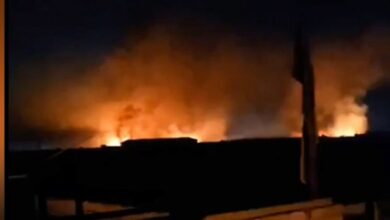Journalist Wendell Steavenson is not the god-narrator in her latest release, The Weight of a Mustard Seed. She is instead an attentive listener and witty teller of the interesting stories of Iraqi generals serving under the regime of former President Saddam Hussein
In a 300-page epic, Steavenson follows the life story of one general in particular, Kamel Sachet. Through it, she relays a microcosmic picture of the 24-year-long regime, as lived and propagated by one of its close loyalists while she glimpses through the messy aftermath of the regime.
Sachet was a military commander in the Iran-Iraq war, head of the army in Kuwait City during the U.S. Desert Storm operation in 1990 and the governor of the Maysan province in southeastern Iraq. Steavenson’s choice of Sachet’s story as the thread of the greater picture of Iraq comes from her interest in developing a narrative approach. “It happened slowly. I wanted to write a story about one person. One way to communicate a bigger issue is to choose one character and follow it,” she tells Al Masry Al Youm in a phone interview from Paris, where the she lives now.
By opting for a character-driven account, Steavenson delves into the complexities of humanizing events and putting faces to facts. Her choice of Sachet was not random. “I happened to come across [Sachet]’s family when I was intrigued by these high ranking baathist officials, those who were inside the system and were both victims and perpetrators. By showing their own doubts and complications, we get an interesting example of those who got stuck being part of the regime and became victims of it,” she says. Using only a victim of Saddam Hussein’s regime would be two-dimensional for her. She reflects on her opinion of the strict binaries of good versus evil and how distant those binaries are from describing reality. “This army, as instrument of the regime, did monstrous things but it was made up of ordinary men who did not seem monsters to me nor that abstracted and overwrought Hollywood ‘evil.'”
Accordingly, Steavenson ventures into a long process of interviewing those who were close to Sachet: his family members, his close associates and his army colleagues – in an attempt to construct his life story. She meets them both in Iraq and in their countries of exile, Lebanon, Syria and England. But while doing so, she uses all those narratives to paint a broader picture of Saddam Hussein’s Iraq, little of which we actually know. Somehow, Sachet is a protagonist but also an excuse to tell the different narratives of Iraqi generals, as well as people living under the regime in general. Steavenson humbly calls it virtue out of necessity. “It is very difficult to find a way to write a book about someone who is dead and the sources about him are elusive and elliptical. It was impossible to find documents.”
Through the body of those narratives we get scattered accounts on particular events. For example, we learn about the entrapments of joining the Baath party in universities in the 1960s and 1970s in the heydays of nationalism and political mobility, and the disappointment that followed. We also get a glimpse of the Iraq-Iran war through the battle of Mohamara in 1980, planned by Saddam Hussein in an Iranian province where he sent the army’s Special Forces. Sachet was a major in those forces and Mohamara was his first victory. The first Gulf War is further demonstrated through the Seif Said battle in 1981, a mountain on the common border between the two countries and the first battle lost by the Iraqis to the Iranians. For the first time, Saddam Hussein shot commanders involved in this battle for their failure, an act that diffused fear amidst the ranks of the military and forced allegiance. The first use of chemical warfare in the Iraq-Iran war is brought up when a gas attack perpetrated by Iraq in the Kurdish mountainous town of Halabja in 1988. The attack was in retaliation for an Iranian push toward the Darbandikhan dam that could cause a flood of Baghdad if totally destroyed. We also learn about the internal strife of military personnel trying to escape service during that war after different battles by self-inflicting harm. The act would usually cost them arrest and detention by the regime’s military security. Through other narratives, we are introduced to Saddam Hussein’s decision to attack Kuwait, to which Iraq was indebted after having received funds for fighting Iran’s Ayatollah Khomeini’s regime. The decision to go to war was received with an element of surprise among the military. We go through the equally messy retreat, which spread depression among military commanders, including Sachet, who was given retirement and the responsibility to govern the Maysan Province. Alongside the military accounts, we are also exposed to changing social norms, particularly trends of religiosity and Islam(ism), through encounters with the wife and children of Sachet.
Steavenson gives the floor to her interlocutors to tell all those stories and she would usually offer a context to those experiences by inviting them to start telling accounts of their lives before they joined the military. Her work becomes an interesting use of oral history techniques in relaying the complex story of a nation in continuous tension. She engages anthropologically in those narratives by revealing fragments of her reactions to her interviewees or even her field notes.
A common trap in making such interventions is to insinuate certain power relations by revealing a level of superiority. But Steavenson escapes it. At times, her voice would show genuine confusion. After presenting the narrative of a man who was part of Saddam Hussein’s bodyguard regiment and who was both a murderer under the protection of the regime and a repellant of its atrocities, she throws this thought: “The human cogs of the torture machine seemed as unhappy as their victims, which meant, as I scribbled down in a notebook, ‘there is no national explanation for the machine’s existence at all’.”
She also does not use pre-conceived and exhausted notions of being an Arab or a Muslim in her interventions and characters’ presentation. For example, she is always keen to present the virtue in Sachet’s character, a character that had religious fervor, courage, stiffness, honor and pride. We get all those attributes through other peoples’ narratives and through descriptions of imagery showing Sachet physically (wall photographs in his house and video tapes of him in service). The overall picture we get of Sachet is meticulously driven from Steavenson’s empirical quest, rather than judgments. Another interesting take in conducting ethnographic work is her encounter with Ahmed, Sachet’s middle and most religious son. Through this encounter, we see a snippet of how Iraqis internalize the current state of affairs in their country. “The occupation is a national humiliation” Steavenson writes after a long conversation with Ahmed, who did not hide his sympathetic views towards jihadi Muslims. In the conversation, she challenges Ahmed’s views of jihad and martyrdom through common arguments of terrorism perpetuating death and loss and lack of tolerance for Islam. But she leaves him to expound on his belief in jihad as a resort to national resistance and as a cornerstone of Islam. We don’t see her necessarily sympathizing or empathizing with him, but she rather relays, with a level of detail, his account, his reasoning and his gestures while doing so.
The conversation between Ahmed and Steavenson is particularly well-placed at this point in the book because the work could be easily criticized for ignoring the overthrow of Saddam Hussein. While the book does not intend to delve into the current occupation of Iraq and is rather fixed on the past, it cannot avoid the very context and conditions of its own production. Steavenson first landed in Baghdad in the summer of 2003, on a commission from London’s Observer newspaper.
Well aware of the traps of representation of a Westerner of a Middle Eastern society, Steavenson tries to listen as much as she can. “One thing I was careful about is not to judge people. I wanted to present Kamel Sachet and his family as reacting to their own society, to put their story in the context of their own society, the real Iraqi context. I felt it is an untested territory and there was a lot of trepidation and responsibility as a foreigner to try to do that. But the best thing is to listen to people.”
At the end, Steavenson’s account does not try to be a comprehensive one of a whole era. It is rather a series of individual stories, somehow choreographed through a chronological development of events and through the recurrent attempt to relay the life story of an Iraqi general in absentia. It becomes an important addition to the body of literature that should emerge and venture into revisiting the complexities of a bygone regime. This work can contribute to reinvigorate a tradition of historic revisionism, investigative journalism and non-polemical academic inquisitions.




